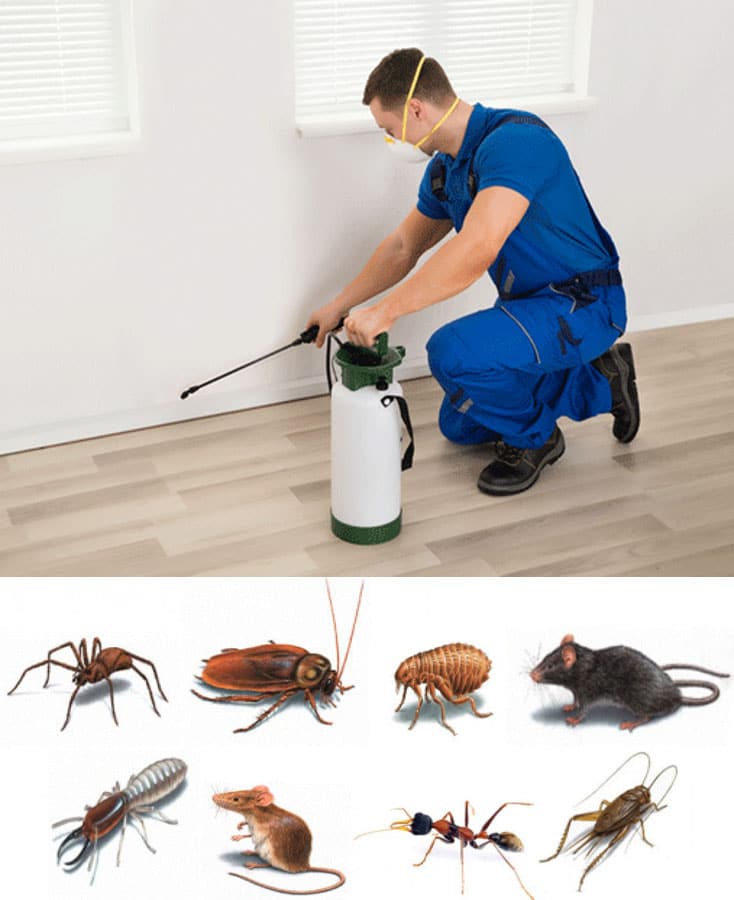Experienced A1 Exterminators Charlotte NC - Rapid and Trusted Solutions
Experienced A1 Exterminators Charlotte NC - Rapid and Trusted Solutions
Blog Article
Bed Insect Therapy Break Down: Comparing Chemical Vs. Non-Chemical Solutions
In the realm of bug control, specifically when handling the relentless problem of bed pests, the choice in between chemical and non-chemical treatment remedies can be a critical one. Both strategies offer distinctive benefits and disadvantages, affecting factors such as performance, security considerations, and general cost. By checking out the nuanced information of each technique, a clearer understanding of which path to seek in dealing with a bed bug infestation can be obtained.
Performance of Chemical Treatments
Chemical treatments for bed insect problems have actually been extensively recognized for their quick and powerful efficacy in eradicating these insects. When thinking about the efficiency of chemical therapies, it is vital to recognize that they can give a detailed and fast service to a bed pest trouble. Professional pest control specialists frequently count on pesticides to target bed pests at various phases of their life cycle, consisting of eggs, nymphs, and adults. These chemicals typically work by interrupting the bed insects' nerves, causing paralysis and ultimate death.
Furthermore, chemical therapies have the benefit of using recurring effects, suggesting that they can remain to remove bed insects even after the initial application. This recurring activity is specifically advantageous in combating any possible re-infestations. Additionally, the rapid action of chemical therapies can bring relief to people dealing with serious bed pest problems, allowing them to reclaim control of their space quickly.
Safety Worry About Chemical Solutions
One critical facet that calls for careful factor to consider when making use of chemical options for bed pest therapy is making sure the safety of owners and the atmosphere. Direct exposure to certain chemicals utilized in bed pest treatments can lead to breathing issues, skin irritability, or other negative reactions, particularly in people with pre-existing conditions or sensitivities.
Additionally, the ecological impact of chemical options is one more significant consideration. Some pesticides used in bed bug therapies may be damaging to helpful insects, wildlife, and communities if they seep into the dirt or water systems. It is crucial to utilize chemical therapies deliberately, complying with safety guidelines, and thinking about much less poisonous choices to alleviate these risks and make sure the risk-free and reliable management of bed bug infestations.
Benefits of Non-Chemical Methods
Considering the prospective safety worries and ecological effect connected with chemical remedies for bed insect treatment, checking out non-chemical strategies presents an encouraging choice with a number of distinct benefits. Non-chemical therapies are eco friendly, as they do not add to air or water contamination, making them a lasting selection for parasite control.
Furthermore, non-chemical options can be reliable published here in targeting bed insects, including hard-to-reach areas where chemical treatments may not pass through. Techniques such as warmth therapy, vacuuming, heavy steam cleaning, and cushion encasements supply extensive elimination without the use of harmful chemicals. Furthermore, non-chemical techniques can be much less disruptive, needing very little prep work and enabling quicker reentry into dealt with locations. On the whole, choosing for non-chemical bed insect therapy methods not just focuses on security and environmental security but also makes certain effective and detailed bug control.
Limitations of Non-Chemical Treatments

In addition, non-chemical therapies commonly call for several applications to accomplish successful eradication. This can be read more lengthy and might not always guarantee total removal of all bed bugs and their eggs, particularly in hard-to-reach or hidden places.
Furthermore, the success of non-chemical treatments greatly relies upon proper implementation and thoroughness, which can be testing for people without expert competence. Poor application of non-chemical techniques may cause incomplete removal, causing persistent invasions and the requirement for added treatments.
Therefore, while non-chemical therapies have their benefits, it is necessary to acknowledge these limitations and consider them when figuring out one of the most reliable technique for managing bed bug infestations.
Price Contrast: Chemical Vs. Non-Chemical Options
Given the restrictions connected with non-chemical treatments, an important facet to assess in the context of bed insect management is the expense contrast in between chemical pest and control and non-chemical choices. Chemical therapies normally entail the application of insecticides by professionals, which can range from $250 to $900 per space, depending on the extent of the problem and the dimension of the location to be treated. In contrast, non-chemical therapies like warmth treatment or steam can be much more costly, with expenses ranging from $1,000 to $6,000 for an entire home. While the preliminary cost of chemical therapies might seem reduced, several therapies might be called for to fully eradicate the invasion, potentially enhancing the overall cost. On the various other hand, non-chemical choices might provide an extra environmentally friendly and lasting remedy, although they can be cost-prohibitive for some individuals. Eventually, when taking into consideration the price of bed bug treatment choices, it is very important to evaluate the in advance expenses versus the effectiveness and long-lasting sustainability of the picked approach.
Verdict

Thinking about the prospective safety issues and environmental influence associated with chemical options for bed bug therapy, checking out non-chemical methods presents an appealing choice with a number of unique benefits.Offered the restrictions linked with non-chemical therapies, a vital aspect to evaluate in the context of bed pest administration is the cost comparison between chemical and non-chemical alternatives. In comparison, non-chemical therapies like warm therapy or heavy steam can be much more costly, with expenses varying from $1,000 to $6,000 for a whole home. While the preliminary cost of chemical therapies might seem reduced, several treatments may be required to completely remove the problem, possibly raising the overall price.In verdict, when contrasting chemical and non-chemical bed insect therapy alternatives, it is crucial to consider efficiency, safety and security, advantages, restrictions, and expense.
Report this page